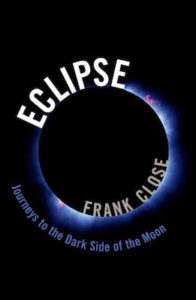On Monday, 26 February 1979, the public schools in my hometown were closed. Not for any designated holiday or scheduled late winter vacation; rather they were closed as the result of an astronomical event: a total eclipse of the sun. Despite the fact that for weeks we had all been rigorously instructed about the dangers of viewing the eclipse without proper eye protection (of which essentially none was widely available there and then; even welding masks were deemed by the teachers as possibly insufficient) and given a rather uninspiring lesson on poking a hole in a shoebox to make a type of indirect viewing tool, at the last minute the superintendent decided that the safest course of action was simply to close the schools and instruct parents to keep their children at home that day – indoors – so that they didn’t take it into their little heads to sneak a peek and blind themselves for life.
Fortunately for Frank Close, presently professor emeritus of physics at Oxford University but on 30 June 1954 then a schoolboy in Peterborough, England, his teacher at that time, Mr. Laxton, was a bit more adventurous. Rather than encourage his pupils either to hide from or ignore the solar eclipse that occurred that day, he kept them outdoors and showed them how to perform some simple but very enlightening experiments during it – the results of which they would then combine during a lesson back in the classroom during which he demonstrated to them just what the data they had collected to show. Like all the very best actions of the very best teachers, this willingness to take time out of an otherwise ordinary school-day to do something different, something immediate and meaningful, made an impression upon Close that set him on a path of life-long adventures studying and following eclipses. It’s a journey he recounts with delightful enthusiasm in his book Eclipse; Journeys to the Dark Side of the Moon.
Following upon the recollections of his school days, and a subsequent chapter introducing the history of eclipses and a bit of general astronomy, Professor Close takes up the chronological development of his progression as an eclipse enthusiast. With a writing style that flows energetically through both his eclipse-chasing adventures around the globe as well as – and this is where the good professor clearly demonstrates that he learned about pedagogy as well as eclipses from Mr. Laxton – easily understandable explanations of the history and mechanics of the eclipses themselves, Eclipse provides the general reader with both the information needed to understand solar and lunar eclipses as well as the inspiration to witness one for him or herself. For woven deftly into the buoyant, travelogue-style narrative of each chapter are a number of superbly well-written, curiosity-piquing descriptions and explanations of aspects of solar or lunar astronomy related to the particular eclipse that chapter recounts.
Indeed, was it not for my reading Professor Close’s Eclipse, I myself, an avid general naturalist who once upon a time was keenly interested in astronomy, was thoroughly unmotivated to pay any more than cursory attention to the solar eclipse predicted for 21 August 2017, the totality band of which is calculated to be no more than 150 kilometers from my own home. Ideed, as my usual trip to Birdfair would overlap this eclipse, I was perfectly content to be in England whist so many were scrambling for a viewing position back in North America. Such are the long-lasting effects childhood interactions with fearful and mediocre teachers can have upon a person.
However now, having read Professor Close’s Eclipse, I am very excited for this upcoming event and even planning to undertake a few experiments of my own during it, as well as preparing to attempt the necessary observations and calculations required by the Astronomical League in pursuit of their Solar Eclipse 2017 Special Observing Award. Such are the restorative and inspiring effects a particularly talented teacher – whether in person or through a book – can have at any time in one’s life.
Given the now plentiful information available about when and where to view the 21 August 2017 solar eclipse, as well as the wide range of equipment that will allow it to be viewed from beginning to end in (so long as the instructions included with said equipment are duly followed) complete safety, there is no reason anyone within viewing range of the eclipse, be that totality or some percentage thereof, should miss this event. And after one reads Professor Close’s entertaining, inspiring, and highly informative Eclipse, there is no reason one should want to miss it.
 Title: Eclipse; Journeys to the Dark Side of the Moon
Title: Eclipse; Journeys to the Dark Side of the Moon
Author: Frank Close
Publisher: Oxford University Press
Format: hardcover
Pages: 208 pp., 8 color plates, 13 black and white line figures, and 18 halftones
ISBN: 9780198795490
Published: May 2017
In accordance with Federal Trade Commission 16 CFR Part 255, it is disclosed that the copy of the book read in order to produce this review was provided gratis to the reviewer by the publisher.
If you enjoyed reading this, please consider signing up for The Well-read Naturalist's newsletter. You'll receive a helpful list of recently published reviews, short essays, and notes about books in your e-mail inbox once each fortnight.
